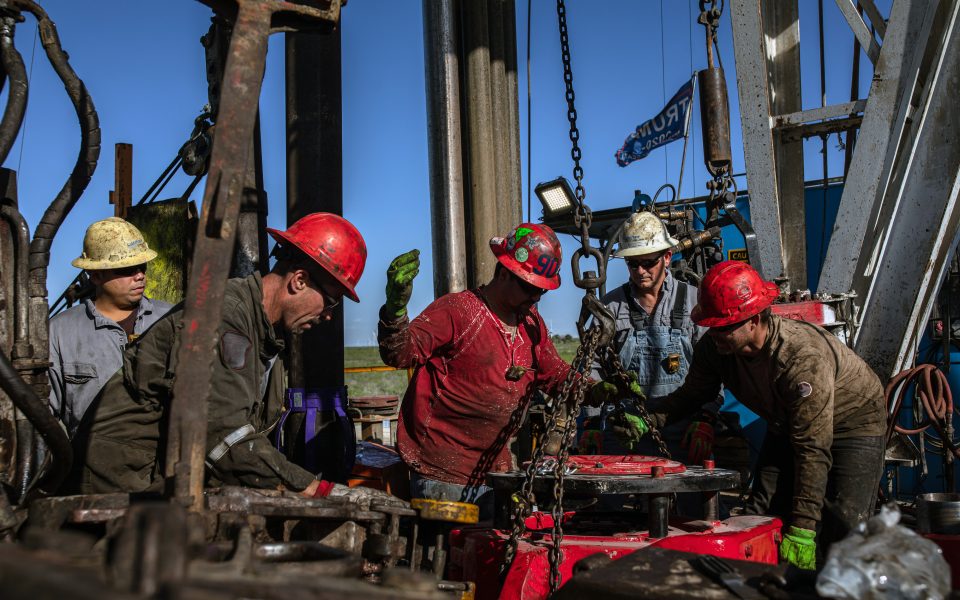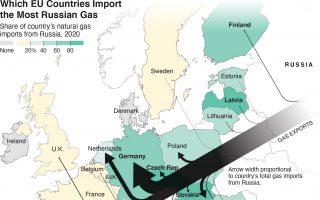Loss of Russian oil leaves a void not easily filled, straining market

Before its forces invaded Ukraine, Russia provided 1 out of every 10 barrels of oil the world consumed. But as the United States and other customers shun Russian crude, the global oil market faces its greatest upheaval since the Middle East tumult of the 1970s.
An energy price shock will probably last as long as the confrontation goes on, since there are few alternatives to quickly replace Russia’s exports of roughly 5 million barrels a day.
Oil prices were already rising as the world economy emerged from COVID-19 shutdowns and producers stretched to meet growing demand. International oil companies had cut back investment over the past two years.
Now traders are bidding up crude prices to levels not seen in years, expecting that Russia – one of the top three oil producers, along with the U.S. and Saudi Arabia – will be sidelined. With the announcement of the U.S. embargo Tuesday, prices will probably climb higher, energy analysts say.
“We are catastrophically tightening,” said Robert McNally, a former energy adviser to President George W. Bush. “What we need right now is countries producing more oil.”
That will not be easy. Only Saudi Arabia, the United Arab Emirates and Kuwait have spare capacity, together a little more than 2.5 million barrels a day. Venezuela and Iran could contribute about 1.5 million barrels a day to the market, but that would require lifting U.S. sanctions against those countries. And the U.S. could increase output by more than 1 million barrels a day – but doing so would take a year to achieve, and require oil companies to harness more labor and equipment.
There have been few comparable disruptions of oil supplies. The 1978 Iranian revolution took an estimated 5.6 million barrels a day off the market, while the 1973-74 embargo by Arab members of OPEC and the 1990-91 Persian Gulf war removed 4.3 million.
A glimmer of hope came out of Venezuela this week as President Nicolás Maduro said he would talk with his domestic opposition and then released at least two Americans imprisoned in his country. It was apparently a response to a weekend visit by Biden administration officials to discuss the lifting of sanctions that Washington imposed in 2019 over election fraud, human rights violations and his close relations to Iran, Russia and China.
But Venezuela’s oil industry, one of the world’s strongest 30 years ago, is a shambles. Its pump jacks and refineries are rusting, and it can barely supply its own people with fuel. Its national oil company will need billions of dollars of investment to return to the market as a major exporter.
Negotiations with Iran to revive the 2015 nuclear deal and open the taps of Iranian exports appeared imminent only a few days ago. But a demand by Russia for a written guarantee from the U.S. that Western sanctions on Russia will not impede Russia’s trade with Iran has cast doubt over the talks.
Should the stalemate be broken, Iran has several hundred thousand barrels of oil stored on tankers that could be shipped immediately. After that, it could add 1 million barrels a day.
Potentially more important are Saudi Arabia, the United Arab Emirates and Kuwait, traditional allies of the U.S. and members of OPEC.
But they are also in a loose alliance called OPEC+, a group that includes Russia. Russia’s deputy prime minister, Alexander Novak, is the co-chair. The expanded cartel has been reluctant to expand production beyond a modest 400,000-barrel-a-day increase scheduled for April.
Saudi Arabia is the leading producer in OPEC and OPEC+, but the kingdom’s relations with the U.S. have been strained. Any break with Russia would require a decision by Crown Prince Mohammed bin Salman, who is out of favor in Washington after being accused of ordering the killing of Jamal Khashoggi, a columnist for The Washington Post.
U.S. officials say they are hopeful that Saudi Arabia and other Middle East producers will increase their output.
“We are in constant conversations with those countries, and we continue to ask for them to do what they can to help out with the situation,” Jose Fernandez, undersecretary of state for economic growth, energy and the environment, said. “These are long-term allies.”
“We are going to feel some pain,” Fernandez added. “We and our European allies are not going to be immune from the pain. At the same time, we have taken these actions in cooperation with our allies.”
OPEC’s secretary-general, Mohammad Barkindo, met with American oil producers at the CERAWeek energy conference in Houston on Monday, but in comments to reporters he offered little prospect that the cartel would relieve market pressures.
“There is no capacity in the world” that could replace Russian output, he said, adding that “we have no control over current events, geopolitics, and this is dictating the pace of the market.”
The U.S. imported about 700,000 barrels of crude and petroleum products a day from Russia last fall, or about 3% of American consumption, U.S. officials say. The quantities have declined since then.
But oil prices – which ultimately determine gasoline and diesel prices – are set globally. Any supplies the U.S. imports to replace Russian barrels – whether from Colombia, Brazil, Canada or Mexico – are barrels taken off a market that is already stretched.
Britain said Tuesday that it would phase out Russian oil imports by the end of the year, and other European countries – far more dependent than the U.S. on those supplies – are under pressure to take similar action. International banks, shippers and insurance companies are balking at deals with Russia. BP, Shell and Exxon Mobil have decided to suspend big operations there.
Shippers are afraid for the safety of their tankers sailing the Black Sea, and refiners are concerned that sanctions will block deliveries of purchased supplies.
Last week Britain banned Russian-owned and Russian-flagged ships from its ports, and the European Union is considering a similar action that could affect 130 tankers, according to Kpler, a commodity data analytics firm.
By next year, new production will be coming from fields being developed in Canada, Brazil and Guyana, but that will not bring any immediate relief at the pump.
China could be the wild card. With depleted inventories and declining domestic oil production, China could take more Russian oil – perhaps most of the combined 4 million barrels a day of U.S. and European imports, Goldman Sachs estimates – at a steep discount.
China will have to decide how closely it wants to be aligned with Russia. But if it does buy more Russian oil, it could reduce imports from the Middle East, effectively freeing up those supplies for Europe and the U.S. It would still take weeks, if not months, to redirect shipping traffic.
On the demand side, American and foreign consumers will probably cut back on their driving should fuel prices remain high.
American producers have doubled their output over the past decade with shale fields around the country and drilling in the Gulf of Mexico. But they reduced investment as the pandemic undercut energy demand, concerns over climate change grew, and investors demanded that the companies return more cash to shareholders.
Thousands of oil workers have been laid off or have left the industry over the past three years. There is also a shortage of sand for puncturing hard shale to capture oil stored in the rocks.
Executives are also reluctant to drill more because when they rushed to do so in recent decades as prices rose, the market frequently crashed, converting booms to busts.
The U.S. produces just less than 12 million barrels of oil a day, about 60% of national demand, and it is now an exporter of both oil and natural gas. (The imports and exports are not entirely interchangeable because grades of oil are suited to differing domestic and foreign refineries.) The Energy Department predicted Tuesday that daily U.S. production would average 12 million barrels this year and rise to 13 million in 2023. That would be 700,000 barrels above the record of 12.3 million barrels in 2019, a tiny increase in a global market of 100 million barrels a day.
Roughly 4,000 wells have been drilled but not yet completed with hydraulic fracturing. Halliburton and other service companies are working near capacity and will need months to get to all those wells. For new wells, oil does not begin to flow until six months after a rig is deployed.
Still, some companies can be expected to produce more to take advantage of elevated prices.
“While the big companies are not going to go crazy and are staying the course,” said Trent Latshaw, CEO of Latshaw Drilling, which operates rigs in Texas and Oklahoma, “the private equity guys, you will see increased activity from them. Hundred-dollar-a-barrel oil, even $90 oil, is a boon for them.”
Private equity firms have replaced investment funds and banks in the oil patch, as they establish small companies and then flip them to bigger companies looking for more acreage, mostly in Texas, New Mexico and North Dakota. Small producers, which are responsible for about one-tenth of American output, also plan to pump more.
“Everything I’ve got is on and going at full speed,” said Darlene Wallace, CEO of Columbus Oil Co., an Oklahoma operator with 25 oil wells. Wallace said she had been holding back an investment of $100,000 to fix one well, but that is about to change.
“When oil is at $60, I’m not going to do that, but I’m just about ready to put the work in it,” she said. “At $100 a barrel, I can put that sucker back to work.”
This article originally appeared in The New York Times.






